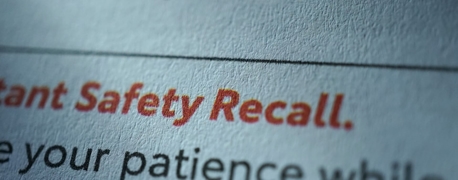Common Vehicle Defects

Car accidents are never planned. Yet, these unexpected events are frequently life-changing for those involved with them. Because of this, the National Highway Transportation Safety Administration (NHTSA) maintains a set of standards for automobile makers. These sets include product liability standards that hold automobile manufacturers liable for faulty and dangerous parts.
The NHTSA requires that “the performance of a motor vehicle or motor vehicle equipment [works] in a way that protects the public against unreasonable risk of accidents occurring because of the design, construction, or performance of a motor vehicle, and against unreasonable risk of death or injury in an accident and includes nonoperational safety of a motor vehicle.”
In other words, car manufacturers must make sure that their vehicles operate as expected and without problems that could cause serious injuries during regular situations—this includes a vehicle’s performance during typical driving conditions and during accidents.
What Are Motor Vehicle Safety Defects?
Understanding what qualifies as a safety defect is important. For example, a car with a steering design that can fail from typical use would be considered as having a safety defect. However, a car that has a steering issue because a driver ignored a problem unique to their vehicle would likely not be considered a safety defect. Essentially, safety defects are problems that are inherent to a vehicle’s design and, as a result, are likely to be widespread.
The NHTSA clarifies its definition of a defect with these two qualifiers:
- Defects pose an unreasonable risk to motor vehicle safety
- Defects may exist in a group of vehicles of the same design or manufacturer, or items of equipment of the same type and manufacturer.
Not all defects are considered safety issues. If a specific model of car has a problem that causes air conditioners to fail, it has a defect. Since this defect is one related to a comfort feature rather than safety, it's unlikely that air conditioner defects would qualify as an auto product liability issue.
Common Vehicle Defects, According to the NHTSA
Knowing what vehicle safety defects are common can help consumers identify and prevent problems that can cause serious—and often fatal—car accidents. The NHTSA provides a list of safety defects that it commonly sees in vehicles.
Common vehicle defects listed by the NHTSA include:
- Steering components that break and cause drivers to lose control
- Fuel system issues that can be dangerous during accidents by triggering a fire or explosion
- Accelerators that get stuck or continue to work when drivers aren’t using them
- Wheels that can’t safely support a vehicle and crack, break, or cause an unexpected loss of control
- Tires that are prone to sudden blowouts
- Engine cooling fans that break and injure mechanics
- Windshield wipers that don’t work as they should and reduce visibility during adverse weather
- Seats that fail during normal use, including those with backs that are susceptible break and cause an accident
- Wiring systems that can trigger fires or stop working when needed at night for safety
- Airbags that fail to deploy or those that deploy when they shouldn’t
- Car seats and booster seats that don’t have adequate belts, buckles, or other components that place children and any other occupants of a vehicle at risk during a collision
Taking a Closer Look at the Most Common Vehicle Defects
Each type of vehicle defect is dangerous for unique reasons. Some are more dangerous than others, and some may be responsible for causing accidents while others are responsible for exposing a vehicle occupant to increased injury. Let's take a closer look at the most common vehicle defects and why they're dangerous.
Seat Belt Defects
Seat belt failure causes about 3,000,000 injuries in the United States each year, according to the NHTSA. If a belt does not latch properly, will not come undone when it's supposed to, or fails to lock into place in a collision, this can cause serious injuries to the very person it is meant to protect. Seat belt defects are dangerous and far too common in the U.S.
Airbag Defects
Airbags are another safety device that can cause severe harm if they malfunction. An airbag may fail to deploy in a collision, leaving the driver or passenger to experience the full force of impact. In other cases, an airbag may deploy when it shouldn't, and this can be just as dangerous. In other cases, airbags may be designed or manufactured in such a way that they deploy too quickly or with too much force, which can cause serious trauma to the person they strike.
Ignition Defects
A defective ignition switch can have deadly consequences, causing an engine to shut off while a vehicle is in motion and preventing airbags from deploying. Perhaps the most famous case involving an ignition switch recall involved General Motors (GM). GM recalled 30 million cars worldwide, paid compensation for 124 deaths, and paid $900 million in penalties to the U.S. as a result of faulty ignition switches.
Accelerator Defects
A defective accelerator is a serious problem in any motor vehicle. Unintentional acceleration can cause serious collisions and can worsen the severity of impact because they are more likely to occur at high speeds. From 2007 to 2011, Toyota recalled millions of vehicles as a result of reported defects in floor mats and accelerator pedals in various Toyota and Lexus models. Numerous accidents and deaths were reported due to gas pedals becoming stuck on floor mats, causing vehicles to accelerate without drivers being able to stop them.
Door Latch Defects
A defective door latch mechanism may not seem dangerous while a vehicle is parked, but when it is in motion, this can have devastating effects. If a passenger leans on a door that has a defective latch, it could swing open and they could fall from the vehicle. A defective latching mechanism could also prevent a driver or passenger from getting out of a car after an accident. These vehicle defects can have serious consequences.
Steering & Braking System Defects
Steering and braking systems are essential parts of how a driver can control a vehicle. If one or both fail, the driver will be unable to avoid a collision. Even with modern dual braking systems, brakes can fail if they are designed or manufactured improperly. Similarly, steering systems may lock up and take control of a vehicle out of a driver's hands. When these vehicle defects happen, they can leave numerous people with catastrophic injuries.
Tire Defects
Sudden blowouts, hydroplaning, and loss of control can be caused by defective tires. Tire defects can also be traced to problems with suspension systems or misaligned tires. One of the biggest tire recalls in history involved Firestone and Ford. High tire failure rates in specific Firestone tires on the Ford Explorer and similar vehicles led to the recall of 14.4 million tires in the U.S. in 2000. Investigations have revealed that these tire defects may have caused 271 deaths in the U.S., dating all the way back into the early 1990s.
Headlight & Taillight Defects
When headlights, turn signals, and taillights are defective, this can have detrimental effects on a driver's ability to see the road and for other motorists to see a vehicle. Other motorists will also be unable to anticipate a driver's next moves, such as braking or changing lanes. These vehicle defects can cause or contribute to severe crashes.
Liability for Vehicle Defects: Who's Responsible?
A poorly designed auto part or defect in the manufacturing process can cause a vehicle to malfunction or may affect its ability to protect an occupant in the event of a crash. When vehicle defects cause a crash or worsen the effects of a collision, at-fault parties should be held responsible. This may be the manufacturer of the defective part, as they have an obligation to design and build products that function properly. It may also be a dealership for knowingly selling a defective vehicle or a mechanic for performing shoddy service or repairs. By investigating vehicle defects and any associated recalls or similar incidents, we can shed light on who is responsible and how to move forward with a case.
Injured Because of a Defective Automotive Part? Help Is Available at (888) 493-1629.
Arnold & Itkin is a trusted name when comes to auto product liability claims. Whether someone is suffering because of defective tires, fuel system issues, or problems with safety features such as seat belts and airbags defects, our team is ready to help. We’ve recovered billions of dollars for clients, often while facing some of the largest companies in the world.
Call our auto product liability lawyers today at (888) 493-1629 for a free consultation. We’re ready to listen to what happened and help you decide what options for recovery are available to you.
- Categories


